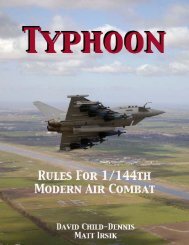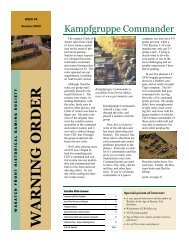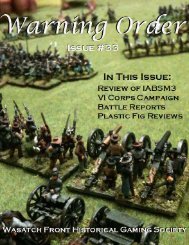Warning Order - Wasatch Front Historical Gaming Society
Warning Order - Wasatch Front Historical Gaming Society
Warning Order - Wasatch Front Historical Gaming Society
Create successful ePaper yourself
Turn your PDF publications into a flip-book with our unique Google optimized e-Paper software.
WW <strong>Gaming</strong>: New Directions (cont.)the other rules in this feature, for $20 it’smore than worth it.Cons: The large scale game, whereshooting can go out to a couple of hundredinches ended up as a game in whichthe armor sat on the edge of the boardand killed anything that tried to move!Using the alternate scale solved this problem,however. Also, the text needs to bebroken up into columns to read the rules abit more easier.I Ain’t Been Shot Mum!IABSM, as it called by it’s supporters,is a new outlook on WW2 skirmish gaming.Using a card activation system, eachsquad gets a variable number of dice,usually 4D6 that can be used for movementand shooting, which gives the playersa wide variety of options. Key to thesystem, however, is the use of “BigMen”, or heroes, who add extra dice,rally troops, and provide the inspirationseen in hundreds of WW2 films. IABSMis backed up by numerous supplementsand a very active Yahoo group.Format: I ordered the PDF version andbound it myself, but you can order abound version. The layout is pretty simpleand constantly changes from professionallooking to amateurish.Cost: $25 or about $10 for PDFScale: 1:1 scale, although it is recommendedthat you base several figures on astand to ease the movement for largegames.Figures: 20 or 25mm probably workbest, but a growing number of gamers areusing their FOW stands and vehicles forIABSM games.Web Support: The Yahoo group hasrules updates, extra cards, scenarios, andmore.Additional Materials: There are a lot ofsupplements and annual issues that havecome out. I bought the Sea Lion supplementand it had about 20 well thought outscenarios in it.Command & Control: C&C is prettybasic, usually with the “Big Men” beingthe focus. Placement of these figures canbe critical to success as they add extradice, can rally troops, and removewounds.Game Systems: The card deck driveswho gets to move, along with specialevents like air support, blitzkrieg moves,events, etc… .Combat is the result of howmany dice each squad or vehicle usesbesides movement. Results are usuallyin terms of wounds, which decrease asquad’s effectiveness by limiting howmany dice they get. The vehicle combatsystem is pretty fun to use and gives optionsfor using dice to aim, move turrets,etc… .Best Rule: using “Blinds” or large markersthat may or may not contain units, isthe best way I’ve seen to handle hiddenmovement in skirmish games.Complexity: On a scale of 1 to 5, probablya 2. Once you’ve gotten the hang ofthe shooting and movement, everythingelse is just adding options into the game.Group Play: Our first game had threeplayers and went extremelywell. Thesecond had seven andit bogged down attimes. I think thegame system is idealfor 4-6 players.Realism: At times itseems like real WW2combat, then it canrevert to a Hollywoodaction film with a Bigman leading a squadthrough a building, clearing out everythingin sight! The card system drives thegame and depending upon the draw theaction can ebb and flow.Pros: I think the most important facet ofIABSM is that gamers seem to enjoyplaying the game and it can be fun. Thedice concept for movement and combatgives you a lot of choices, plus the use ofBig Men adds flavor to the game. Thesystem is easily expandable with extracards, scenario books, additional rules,etc…, which enables the game designerto create virtually any type of WW2 combataction.Cons: The rules are similar to TSATF inthat there are a lot of gaps in the rules thatcan be subject to interpretation. If youplay with a lot of rules lawyers, thenIABSM is a bad idea. The cards that canbe inserted into the deck can have a profoundinfluence and could quickly imbalancethe game, so the scenario designerneeds to carefully plan out the deck.Since the turn can end anytime, in largegames you can have the situation where aplayer’s units may not move for severalturns, which in real time could be an houror more of just sitting around. In oursecond game one player did not have hisplatoon card pulled for three turns, ofwhich two were quite long, so for aboutan hour he just sat there and wasn’t toohappy about it.Final ThoughtsCompared to the 70s and 80s, wherepretty much all the WW2 rules werevariations of the same theme, we have amultitude of innovative systems tochoose from today. The search for realismin WW2 rules hasgiven way to playability,which is both ablessing and a curse.Gamers can now playa variety of WW2miniatures games andachieve a result in afew hours withoutneeding a physicsdegree to decipherballistics charts. Onthe other hand, someof the recent games I’ve seen and been apart of seem more like Hollywood thanWW2 combat.So, what about the future of WW2gaming? No doubt there will be moresets of rules, each trying to define whatthe author thinks how WW2 armoredcombat should be. There will be newsupplements, figures, terrain, etc…, butit’s my belief that we’ve come close toreaching the ceiling for WW2 gamingwith these four sets of rules. They havepresented a whole new series of innovationsthat have pretty much exhausted thelimits of what can be done in WW2 gaming.Page 14WARNING ORDER







